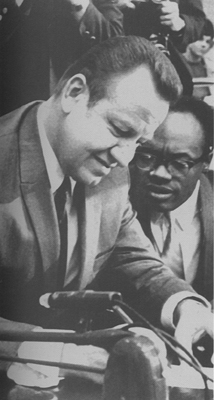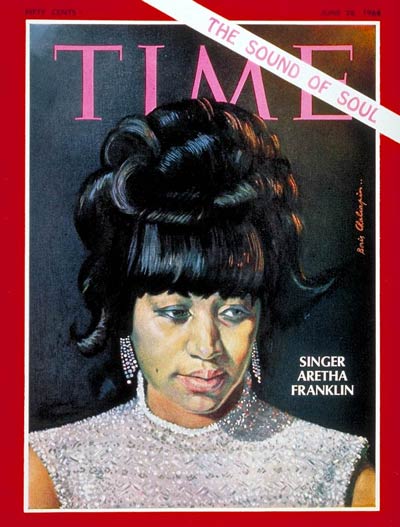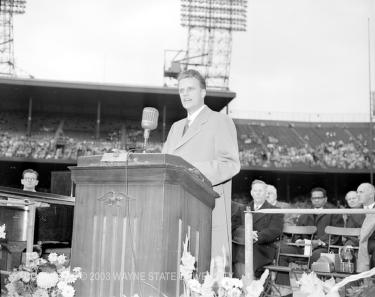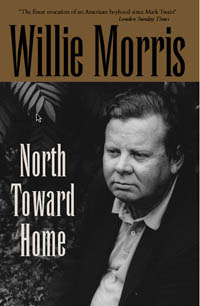|
It started on the very first day that the freshman Assemblyman arrived in
Sacramento. Still exhilarated from his upset victory, Willie Brown was confident
that as the first African American from San Francisco elected to the legislature
he could make a difference. Always sure
of himself, he was perhaps less sure when it came to the rules of the California
Assembly. There was one critical rule that year, 1965, and it was simple:
Don’t mess with Big Daddy! Big Daddy was the 300-pound speaker of the
Assembly, Jesse Unruh. The press called him a "political boss" and
claimed he pulled more strings than the governor, Edmund G. "Pat"
Brown. In fact the governor and the speaker had mostly worked together. Over the
previous six years they passed a remarkable package of legislation that had
given the state strong civil rights laws, redesigned education, transportation,
and water systems, and financed ambitious urban and poverty programs. The
governor took most of the credit, Unruh through his ruthless control of the
legislature, had done much of the heavy lifting. He did not mind being
notorious, although he disliked the Big Daddy label, which had come from
Tennessee Williams’s Cat on a Hot Tin Roof. What he disliked even more were
legislators who did not know their place. He was not going to like Willie Brown.[i]
The Willie Brown-Jesse Unruh contest
is one of the best-loved stories of recent California politics. A feud that
turned ultimately into a succession story, it began on the first day of the 1965
session when Brown refused to support Unruh’s re-election to the speakership
because Unruh had campaigned for Brown’s primary election opponent. Even the
Republicans knew better than to hold out on Big Daddy. Unruh promptly
retaliated, and over the next several years the Assembly understood that the
very junior Brown and the very powerful Unruh were at war. Less obvious was the
fact that a kind of mentorship had been going on almost from the start. Willie
Brown was Jesse’s star student. Long before Big Daddy quit the legislature he
had come to admire the younger man’s ability to play the game of power. Unruh
at one point in 1967 offered a complement. “It’s a good thing you’re not
white,” said Jesse. “Why’s that?” asked Willie. “Because if you were,
you’d own the place.”[ii]
California journalists retell this
story both because it unites two of the state’s most flamboyant political
personalities and because it confirms one of the central fables of late
twentieth century America, the great transformation in racial opportunities that
has taken place since the 1960s. Willie Brown did go on to “own the place.”
Elected Speaker in 1981 with Unruh’s help, he served longer (15 years)
with more ingenuity than any predecessor, including Big Daddy. Without missing a
beat, Brown then moved up the political ladder, winning election as San
Francisco’s mayor in 1996 and holding on to that office through thick and thin
until term limits ended his reign in 2003.
The fact that Brown managed to out-do his mentor has served to make the
story of their relationship all the more interesting. In Willie and Jesse
California finds a comforting tale of racial progress, of the transformation
from an old California where only whites like Jesse Unruh held power, to a new
California that gives power to Willie Brown.
But the Jesse Unruh-Willie Brown
succession story has another dimension that few Californians realize and that in
some ways complicates the neat dichotomies of old and new, white and black.
Jesse Unruh was not part of old California, anymore than Willie Brown was. In
fact neither man was a Californian, neither had grown up there. And their
backgrounds were curiously similar. Both were southerners. In fact both were
Texans.
Unruh, whose parents named him after
the train robber Jesse James, was the son of
north- Texas sharecroppers. Brown grew up in east Texas in circumstances
that his biographer says may have been marginally more fortunate than Unruh’s.
Brown’s family had a long history in the all-black town of Mineola and owned a
nice home, even if money was short by the time he was born in 1934.
Willie was raised by his grandmother, aunts, and uncles while his mother
lived in Dallas where she worked as a maid. His father, a waiter, left when
Brown was four or five. Unruh was not born into poverty in 1922, but watched his
family descend into it, as his father lost his job as a bank clerk, then tried
sharecropping, managing to eke out only the barest of livings through much of
the 1930s. Both Texans benefited from family commitments to education and each
did well in school. After briefly trying college, Unruh in 1941, at age eighteen,
decided to hitchhike to Los Angeles thinking he would work in a defense plant.
When the war broke out, he enlisted in the Navy, spending the next three years
in the lonely Aleutian Islands, making plans for his future. Those plans were
fixed on Los Angeles and a college education. When the Navy let him go, he took
his GI bill and enrolled at the University of Southern California, finding there
his love for politics. Even before he graduated in 1948 he was planning a way
into politics. [iii]
Willie Brown was entering high school
that year, the segregated high school in Mineola. When he graduated three years
later, he briefly enrolled in one of the colleges that Texas set aside for
African Americans, Prairie View A&M near Houston. But another idea had been
brewing: he would go to Stanford. It was an impossible dream of course. There
was no money and Brown’s academic credentials would never pass muster at the
elite school, but an uncle lived in San Francisco and 17 year-old Willie Brown
figured that was pretty close. Stanford was on his mind in the summer of 1951
when he boarded the train heading west: “I came out with the intentions of
going to Stanford and becoming a math professor.”[iv]
That these two Texans should cross
paths in California in the mid 1960s was not particularly surprising.
For more than half a century, Texans and other southerners had been
leaving home by the hundreds of thousands, joining in a massive regional
diaspora that had changed the face of race and politics and other dimensions of
life in many corners of America. California felt the effects along with other
western states, but the diaspora had also delivered its millions to the
industrial states of the Midwest and Northeast. The numbers were enormous. By
the end of the 1960s so many black southerners and white southerners had left
the South that it was as if the entire population of Alabama, Mississippi,
Tennessee, and Arkansas had fled. Close to eleven million former southerners
could be counted living outside the South in 1970. And that number is just a
snapshot of population movements that over the course of the twentieth century
involved millions more, not all of whom left the South permanently. Altogether
more than 28 million southerners—black and white—participated in the
southern diaspora.[v]
Aretha Franklin and Merle Haggard
should have crossed paths in the late 1960s. The two entertainers stood atop
their respective branches of popular music: she the reigning queen of soul, he
the king of country music. Like Brown and Unruh, they had more in common than
they would have realized. Both were children of the southern diaspora.
Franklin had grown up in Detroit after her family had moved there from
Tennessee, Haggard in Bakersfield, California after his parents relocated from
Oklahoma. Their music continued the symmetry. Aretha recorded "Respect”
in 1967, a song that instantly became a ringing anthem of black pride. Almost in
answer, Merle Haggard wrote "Workin' Man Blues" and "Okie from
Muskogee"--anthems of the angry and conservative white working class.
Seemingly politically opposite, the two musicians, both part of the diaspora,
symbolized some of the sharpest polarizations in American politics and culture
by the end of the 1960s.[vi]
This book is about Brown and Unruh, Franklin and Haggard, Graham and
another Franklin, Murray and Morris, and the millions of other diaspora
southerners and their impacts on twentieth century America. It is the first
historical study of the southern diaspora in its entirety. Historians have until
now fragmented the subject along lines of race and time period. The migration of
African Americans out of the South has been studied extensively, especially in
its early phase during and after World War I. Less has been written about the
more massive sequence of migration that began during World War II and a
comprehensive treatment of the century-long story of black migration does not
exist. Studies of white southerners on the move are more limited in number and
most focus on particular segments of that migration. Those who have written
about the movement of Appalachians and other southerners into northern cities
pay little attention to the so-called Dust Bowl migration to California and visa
versa. [ix]
This book assembles and disassembles the various sequences of southern
outmigration. African Americans and whites left the South for somewhat different
reasons, moved in somewhat separate directions, and interacted on very different
terms with the places they settled. In most respects we need to think in terms
of two Great Migrations out of the South. But they were also related. There were
similarities as well as differences in the motivations for leaving the South and
certain parallels along with huge differences in what black and white
southerners experienced and accomplished in the North and West.
One of the strategies of this book involves the side-by-side comparison
of the dual migrations. That stereoscopic view yields a host of new insights
about each of the groups and their experiences. The chapters that follow will
challenge many of the standard assumptions about the experiences of these former
southerners. The image of white Southerners struggling through decades of hard
living in "hillbilly ghettos" like Chicago's Uptown crumbles as we
widen the frame of reference. So do some of the stories that emphasize
disappointments and failures among blacks. Comparison of the community building
and political activities of the two groups is equally productive. The political
accomplishments of African Americans become all the more impressive when set
next to the endeavors of the much more numerous white migrants.
There is another reason for
integrating these stories. In complicated ways the fate of white and black
southerners outside their home region was often intertwined.
Especially that was the case in the two decades following World War II
when sociology and journalism created powerful arguments that linked the two
populations of former southerners. Moreover certain venues and projects drew
upon southern culture in ways that sometimes pulled the two groups of
expatriates into relationship. We see this in the postwar transformation of
northern Protestantism and the separate but in some ways complementary influence
of the evangelical churches that black migrants and white migrants built.
Likewise we see it in the transformation of American popular music—in the
country music that the white migrants helped spread as well as the multiple
genres that black migrants pioneered. And in the reconstructions of northern
politics-- the new forms of urban politics and racial liberalism that black
migrants forged, and the new forms of white-working-class conservatism that
white migrants helped shape. Even when their lives were separate, the two groups
of former southerners were never out of touch.
The book is not just about what the dual streams of former southerners
experienced. More centrally it examines what their comings and goings, their
struggles and creations, have meant for the United States over the course of the
twentieth century. The southern diaspora is one of the missing links in
historical understandings that recent century. As we will see, the great
migrations of black and white southerners were instrumental in many of the key
domestic transformations that the nation experienced, especially
reorganizations of race, religion, and region.
Some of the major stories of recent American history look very different
when viewed through the lens of the southern diaspora.
One story that looks different concerns black struggles for civil rights.
It is widely understood that migration to the North was important to the battle
for rights and respect, but the geography of black politics has rarely been
carefully examined. Here we pay close attention to the ways that African
American migrants were able to use the unique political capacities of the great
cities where they settled and how that political influence translated into
policy changes that transformed racial relations first in the North and West and
then also in the South.
The revival and spread of evangelical Protestantism (both black and white
versions), the southernization of American popular music through the
circulations of jazz, blues, hillbilly, and country music, new forms of black
politics and racial liberalism and new forms of white supremacist and
conservative politics were also part of the diaspora effect. Indeed key
political realignments of various kinds pivoted on the two groups of southerners
living outside their home region.
The reformulation of regions is another legacy of the dual diaspora.
Classical economists see migration as an equilibrium mechanism that over time is
supposed to balance labor surpluses and lead to a convergence of standards and
wages. This book pursues an argument that bears a superficial resemblance to
that theory but undermines its logic. Migration in this analysis contributed to
a convergence of many regional forms, not just economic but also political and
cultural. Southerners outside the South participated in a sequence of historical
transformations that changed the regions where they settled and also changed the
South, bringing the racial, religious, and political institutions of each into
closer relation. But no equilibrium theory can explain this convergence. These
changes prove to be the work of actual people not abstract economic processes.
Southern migrants of both races became agents of change, who used the
opportunities of geography to alter the cultural and political landscape of the
nation and all its regions.
Region is a fluid geographical concept
in the American context. States are the sub national spaces recognized in the
Constitution and equipped with clear boundaries and governmental institutions,
while regions are spaces of uncertain integrity and confusing borders. That is
true even of the South, long the most definite of American regions thanks to the
history of spatialized conflict over slavery and race. "If you look at the
whole South long enough," writes sociologist John Shelton Reed, "it
goes all indistinct around the edges. If you continue to stare, even the middle
can seem to melt and flow away." So scholars fight endlessly about how to
bound the South and describe its core meanings and structures. Those struggles
have their uses, but not to this study. We will define the South loosely and
even inconsistently, recognizing that definitions can change over time and
depend upon perspective. Is Florida a Southern state? Some would say yes at the
start of the twentieth century, no after decades of migration from New York and
Cuba. Are Baltimore and Washington D.C. southern cities? The argument here
involves not only change over time but racial perspectives. What makes a space
seem southern can differ for whites and blacks. For most purposes we will follow
the Census Bureau definition of sixteen states and the District of Columbia
(Alabama, Arkansas, Delaware, Florida, Georgia, Kentucky, Louisiana, Maryland,
Mississippi, North Carolina, Oklahoma, South Carolina, Tennessee, Texas,
Virginia, West Virginia). But at other points we will reopen the issue of
boundaries. [x]
Race is another concept that requires
a note of clarification. White and black are never neat categories, even in a
place like the South that did so much to inscribe them in law and where until
late in the twentieth century low volumes of immigration minimized ethnic and
religious diversity within the two dominant racial groups. Although there will
be many generalized statements about white southerners and black southerners,
more nuanced discussions at certain points will remind us that these are
complicated population identities with mutable boundaries. In addition, it is
important to note that not all southerners acknowledge either racial label and
that southern-born Latinos and Native Americans also left the region during the
diaspora period. Their experiences will be distinguished briefly at some points
but unfortunately cannot be adequately examined in this study.
The book proceeds thematically rather than chronologically—the usual
strategy for a work of history. Each chapter is an essay that addresses a set of
particular questions using a stereoscopic method that moves back and forth
between the two groups of southerners. Stereoscopes set two similar but
different images next to each other, tricking eyes and brain into fusing the
images in a way that makes them three dimensional. Teasing out that third
dimension is the goal of this book. Viewed in relation to each other, the black
and white southern diasporas reveal the subject in entirely new ways.
Chapter 1 is an overview of the migration cycles and the changing
economics and demography over the course of the twentieth century. It offers a
new method for calculating migration volumes and shows the southern diaspora to
have been numerically larger than previous scholars have understood.
Chapter 2
surveys the public meanings surrounding the two exoduses and highlights the
unique role that media institutions and social scientists played in shaping the
expectations and interactions of southerners on the move.
Chapter 3 answers
questions about the economic experience of white and black southerners,
dismantling the maladjustment paradigm that has been so prominent in previous
scholarship while also showing the critical differences in the opportunity
structure facing black and white southern migrants.
Chapter 4 examines the
communities that African Americans built in the major cities, resurrecting the
label “Black Metropolis,” and mapping the new and powerful cultural
apparatus of those communities.
Chapter 5 examines the very different community
formations of white southerners who spread out through suburbs and rural areas
as well as big cities and struggled with confusing issues of social identity.
The whites, too, developed cultural institutions of historical import. Both
diaspora country music and a white diaspora literary community would reshape
understandings of region and race.
Chapter 6 explores the diaspora’s impact on
American religion as both groups built Baptist and Pentecostal churches and
helped revitalize and spread evangelical Protestantism, with important political
as well as religious implications for America.
Chapter 7 develops the issue of
black political influence, demonstrating how important geography was to the
initial phases of what ultimately becomes the civil rights movement.
Chapter 8
brings the white migrants into the story of race, class, and regional
transformations, exploring contributions on the one hand to white-working class
conservatism and on the other hand to new formulations of white liberalism.
Chapter 9 brings the diaspora to a close in the 1970s and 1980s and summarizes
some of the major findings of the book.
A short invocation before we begin. This book in its largest sense is a
call for new thinking about internal migration, one of the seriously under
analyzed issues of twentieth century American historiography. While the
scholarship of earlier centuries focuses imaginatively on the figure of the
Moving American and treats the westward migration of Euro-Americans as a pivotal
historical force, historians of the most recent century sideline the subject of
internal migration. Migration is treated as an important matter for African
American history, but other population movements rarely enter into the
calculations of those writing the history of the American twentieth century.[xi]
If historians have failed to adequately address the subject, social
scientists have not done much better. Migration studies, once a cutting edge
enterprise for sociologists and economists, have been stuck for decades in dead
ends and stale formulations. Most of the work cannot get beyond the question of
why migrations happen, the old push-pull conundrum. Huge debates rage between
advocates of neoclassical economic theory and dependency theory, both of which
contemplate migration as a response to differential economic development. A
third formulation, migration systems theory (a version of which is sometimes
called exodus theory), moves beyond economic conditions, treating migration as a
social movement and specifying institutional and social-cultural factors that
enable mass relocations, but it too concentrates solely on the causes of
migrations while ignoring their effects. All of these perspectives see moving
people as subject to history but not its architects.[xii]
An old theory, dating back to the
late nineteenth and early twentieth centuries, holds some promise. It conceives
migration is a fundamental force of history. The social scientists who crafted
it had in mind conquest migrations of the sort that rearranged European and
Asian empires in millennia past, or that transformed the Americas when Europeans
came swarming across the Atlantic. But
conquest may not be the only basis through which moving masses can redirect the
flow of history. Infiltration can also be powerful. Certain peoples moving into
certain places have managed to impart dramatic changes, achieving conquests of a
sort without warfare and sometimes without major conflict. Can internal
migrations have consequences of this sort? If so, how? Those are the questions
animating this book. [xiii]
Billy Graham and C.L. Franklin should also have met. Fellow Baptists,
fellow evangelists, fellow southerners who had built great religious enterprises
in the North, they understood that they had much in common. As ministers of the
gospel they shared a mission. They would have prayed for their nation to heal
its divisions and come together in a spiritual revival that would sweep away the
hatreds of race. But even as their prayers might have joined, the meanings
behind them would have been different. Graham, the most famous white Protestant
leader of his day, a son of North Carolina who from his base in Minnesota had
changed the face of evangelical Christianity, making it respectable where it had
once seemed backward, preached a Christianity that was nine parts personal
salvation. Franklin, a son of Mississippi (and
father of Aretha), had been for many years one of the nation's most famous black
evangelists. His sermons, recorded at New Bethel Church in Detroit, were known
and loved throughout black America. But unlike Graham's, Franklin’s preaching
was not just about personal salvation. He also called for African Americans to
stand together in the fight for rights and justice.[vii]
Unlike these other pairs, Albert Murray and Willie Morris did know each
other. Indeed the black writer and the white writer had spent New Years day 1967
together in Murray's Harlem apartment, drinking bourbon, talking politics, and
thinking about their parallel and unparallel lives. Morris, the 32-year old
editor of Harper's Magazine was just then completing a memoir, North
Toward Home, filled with critical memories of Mississippi and of the
conflicts that rattled the faith of a liberal white southerner living in New
York City. He wanted Murray to write something for the magazine about his own
life's journey from rural Alabama to literary Harlem. Murray would eventually
take the assignment and turn it into memoir whose syncopated rhythms and
perambulating conversations had little in common with North Toward Home.
But the title, South to a Very Old Place, suggested something of the
linked origins of the two books and the intertwined lives of their authors.[viii]
|

Willie
Brown and Jesse Unruh.


Brown
helps Unruh count the votes as Jesse is re-elected Speaker of the
California Assembly in 1968 (Sacramento Bee photo courtesy City of
Sacramento Archives and Museum Collection Center)

Aretha
Franklin was the "Queen of Soul" when she appeared on the cover
of Time May 28, 1968

Merle Haggard
on the cover of Time May 6, 1974

Above: C.L Franklin in the
1960s. Below: Billy Graham on a Detroit
visit in 1952 (Courtesy Walter Reuther Library, Wayne State University)


Albert Murray and
Ralph Ellison

Willie Morris 
|